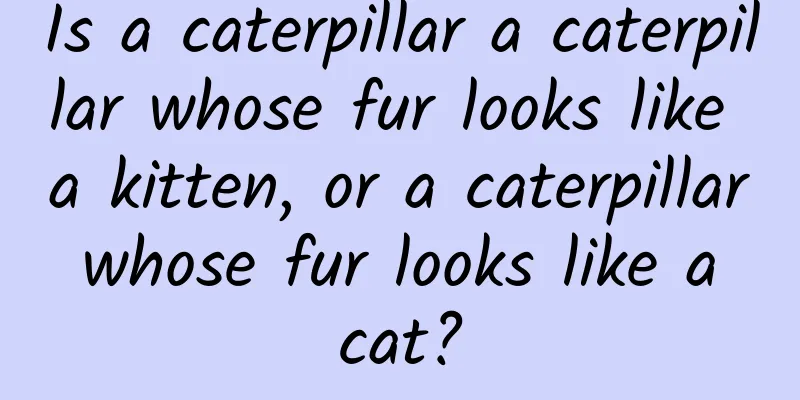Is a caterpillar a caterpillar whose fur looks like a kitten, or a caterpillar whose fur looks like a cat?

|
"Survival of the fittest", this sentence from Darwin's "Origin of Species" is the most appropriate to illustrate the evolution of nature. In order to survive, creatures in nature will do anything to survive. Today we will take a look at one of nature's best mimics: the Cinereous mourner. Why imitate a caterpillar? The caterpillar is 12 cm long, while the chick is about 14 cm long before the 14th year, which is very close to the length of the caterpillar. Image source: "Morphological and behavioral evidence of Batesian mimicry in nestlings of a lowland Amazonian bird" The Chestnut-winged Umbrellabird lives in the humid tropical rainforests of South America. It was officially named by ornithologist Louis Pierre Vieillot in 1871 using Linnaeus's binomial nomenclature. The young have a bright orange costume that resembles a large poisonous caterpillar, and even behaves like a caterpillar when they wriggle in their nest. The young bird lives in a cup-shaped nest built by the adult bird. From the sixth day after hatching, the young bird learns to camouflage. When it senses danger, it will slowly wriggle its body, crawling from one side to the other like a caterpillar. Even if their mother returns with food, they will not remove their disguise until their mother sends a special signal and the chicks are sure they are safe before begging for food. This process will last for two weeks, after which black spots will gradually grow on the orange down of the chicks. Around 16 days, the chicks' feathers gradually grow and they stop moving like caterpillars. Around the 20th day, the chicks leave the nest, and the mother will stay nearby to take care of them for a while before letting them go. It is currently believed that the object it imitates is the American caterpillar (Megalopyge opercularis), and it may also be the only bird discovered so far that imitates a poisonous insect. Compared to the strange clothes of its childhood, the adult bird has gotten rid of its childhood "naivety" and looks ordinary. The adult bird is about 20 cm long, with gray feathers, orange-yellow spots on the tips of its wing feathers, and two orange stripes in the middle of its wings. Image source: "Morphological and behavioral evidence of Batesian mimicry in nestlings of a lowland Amazonian bird" Batesian mimicry As early as 1982, people discovered the peculiar feathers of the Chestnut-winged Umbrellabird, but it was always believed that the feather color of the Chestnut-winged Umbrellabird was imitating the dead leaves in the bird's nest, which was a protective color. It was not until 2012 that scientists discovered the caterpillar, a larva of the wool moth family that also lives in America, that they discovered that the young Chestnut-winged Umbrellabird was actually imitating it. The behavior of a non-venomous species imitating a poisonous species in color, behavior, and body shape to confuse predators and avoid being eaten is called Batesian mimicry. For example, the Papuan swallowtail butterfly (Papilio laglaizei Depuiset) imitates a moth (Alcidis agarthyrsus) that is active during the day. The swallowtail butterfly uses the orange-yellow spots on the anal fold of its hind wings to simulate the bright orange color of the ventral abdomen of a moth. When the swallowtail butterfly is at rest, this part just covers the abdomen, thus achieving the purpose of "pretending to be" a moth. The tropical rainforest is full of dangers and predators are watching closely. The Chestnut-winged Umbrellabird usually builds its nest in the lower part of the tree canopy, which makes it easy for monkeys and snakes to prey on its nest. In addition, the long brooding period of the Chestnut-winged Umbrellabird, the low feeding frequency of the chicks, and the slow growth of the chicks undoubtedly increase the mortality rate of the chicks. The Chestnut-winged Umbrellabird may have evolved this kind of mimicry behavior in order to cope with this survival pressure. Caterpillar: "Why do you want to learn from me?" In nature, slow-moving caterpillars are seen as a meaty, nutritious delicacy by predators. In order to change its fate, the American caterpillar (also known as the "serpent caterpillar", scientific name "velvet moth larva") has evolved its own unique way of survival. Does its name remind you of a harmless kitten? But in reality... Image source: bilibili "Cat Caterpillar", looks cute, but it is the most poisonous caterpillar, it hurts you to the bone if you touch it! Screenshot The growth process of the caterpillar is the same as that of other caterpillars. It also has to go through several moltings. Each time it molts, it will grow a little bigger and its hair will become smoother, like a head of golden hair, which makes people want to touch it. But please stay rational! Because there is a secret hidden under the hairs - each hair is equivalent to a "poison needle", and each "poison needle" is connected to a poison gland. Once triggered, the toxin will be injected into the body of the "poor person" who offends the caterpillar. Descriptions of how it felt after being stung by a caterpillar vary, probably depending on the dose, but common reactions include: "I felt like I was hit by a hammer" and "I've had kidney stones before, but I'm sure this caterpillar caused much more pain than that." Symptoms of stings range from dizziness, burning pain, and fever to mild but strange "abdominal pain." Therefore, other animals remember these poisonous caterpillars and no longer bother them. The Chestnut-winged Umbrellabird takes advantage of this and puts on the caterpillar's coat to keep safe. Image source: bilibili "Cat Caterpillar", looks cute, but it is the most poisonous caterpillar, it hurts you to the bone if you touch it! Screenshot References: 1. Zhang Xiao, Fang Shiwei, Ren Dong, Yang Qiang. Historical development of insect mimicry[J]. Journal of Environmental Entomology, 2009, 31(04): 365-373. 2. Matt Simon (USA); translated by Wu Meng. Crazy Evolution: The Weird Species in the Animal World and Their Survival Skills [M]. Beijing United Publishing Company, June 2018. 3.Sekar, Sandhya.Bright chick plays tricks on would-be predators[J].New Scientist,2014,Vol.115,Vol.224(No.3000-3001):13 END Review expert: He Jiale, project officer of WWF Northeast Resident Working Group. Tadpole Musical Notation original article, please indicate the source when reprinting Editor/Xiao Xitushuo |
<<: What changes will happen to a girl's body if her menstruation stops?
Recommend
How much does Tencent Zhihui charge for advertising? How effective is Zhihuitui?
Tencent Zhihuitui has a large number of platform ...
Sony A55HN player: a baptist of the soul, making your ears feel like they are pregnant with music
Listening to music is a baptism of the soul. In t...
Who is being cheated by the Windows 10 forced upgrade?
As early as when Windows 10 was released, Microsof...
Even Durex can't save you! How to create copywriting that satisfies customers!
It is difficult for us to find a way to satisfy an...
iPhone 6 is about to be released, and iPhone 5s has been fully discounted to clear out stock
Next week, iPhone 6 will be unveiled. The reporte...
In-depth review: Where is fast charging for new energy vehicles heading from the perspective of batteries?
1. Fast charging trends of batteries with differe...
Why does dandruff increase in winter?
Reviewer: Zhang Yuhong, Chief Physician, Departme...
How do spacecraft fly along their orbits? How do two spacecraft find each other? What are the things about space station rendezvous and docking?
The rendezvous and docking is when two spacecraft...
After half a year, the flagship is still fragrant, Sony 65 X8500G TV is experienced again
When buying a TV, look at Sony. For the large scr...
APP operation and promotion: How to attract 20,000 new users in January at 0 cost?
Some time ago, I wrote an article titled "In...
So the question is: Among WeChat, Weibo, and Tieba, which fan economy platform is the best?
Double Eleven has not yet arrived, but the "...
Hot search! 2-year-old boy faces amputation, just because he went to the vegetable market? Doctors urgently remind →
Recently, the topic #2-year-old child infected wi...
Short video promotion: How to quickly attract users and achieve conversions?
In the era of content consumption, short videos h...
From power generation to deep space exploration: Microalgae offer a sustainable future
Life originated in the ocean. In the ocean, the m...
12.12 is coming, please check out the wedding photography industry’s advertising secrets!
Following the popularity of 11.11, the 12.12 prom...









